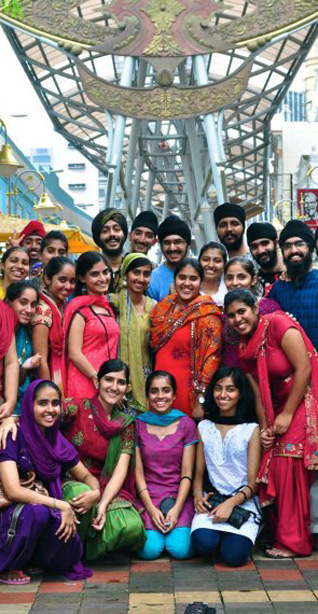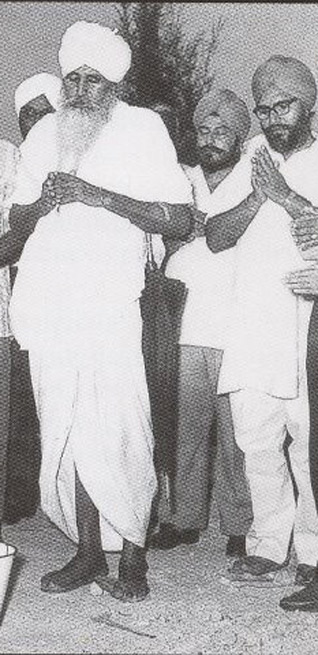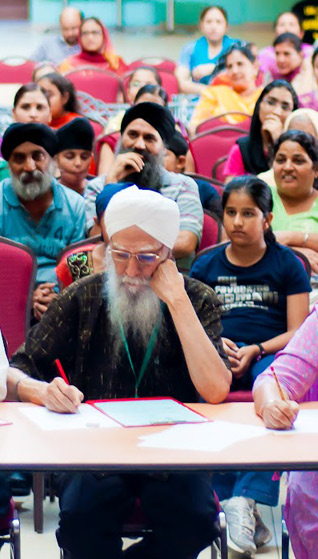People
50 Years of Yeoman Service:
The Amazing Sikh Naujawan Sabha of Malaysia
DYA SINGH
Though the official literature says its inception was in 1966, people remember samelans held by the Sabha as early as 1962. Others in my age group or older would swear that they started perhaps even earlier.
I do know for a fact, that the 'official' Sabha idea germinated in 1961/2 when the first two samelans were held in Port Dickson on the west coast of Malaysia under the auspices of Baba Sohan Singh.
So for me, this is their 50th anniversary.
Malaysia's favourite and most revered Elder, Baba Sohan Singh, who any Sikh-Malaysian swears by, alongside other Sikh luminaries - like (Headmaster) Gurbachan Singh, Master Joginder Singh, Hardial Singh of Seremban, Master Manjit Singh (whose untimely demise robbed the Sabha of a great youth leader), Master Karminder Singh, Sarjit Singh 'Bassian' and 'ham-radio enthusiast and space communication expert' Sangat Singh - were the initiators of the Naujawan Sabha idea which was then formalized in 1966.
"There was great opposition from some gurdwara 'perbhandaks' who felt that 'naujawan' activities must be run by gurdwaras, not an exclusive youth organisation", recollected founding member Joginder Singh when I met him recently in Adelaide, South Australia, where he now resides.)
I do not think a single year has gone by since without the Sabha conducting at least one samelan in Malaysia. Samelans - lterally, gatherings or conventions - are also facilitated and conducted today all over South East Asia, and as far as Australia and New Zealand. In fact, virtually every weekend there is either a mini-samelan or some other Sabha activity in some part of Malaysia, including Sabah and Sarawak.
The annual samelan is normally held shortly before Christmas in a university or technical college and averages about 1000 participants and about 300 sevadars providing langar, security and also home trained facilitators fully versed in Sikhi perchar, kirtan and katha.
The event climaxes with an 'amrit sanchar' ceremony for those inspired and prepared to take their vows as Khalsa.
Today the Sabha boasts real estate, a healthy bank balance, even a stocks-and-shares investment portfolio, to further Sikhi parchar activities along Rehat Maryada lines, while maintaining its autonomy.
A few of the original founding members are still around: namely Joginder Singh Ji in Adelaide, South Australia, Karminder Singh in Temerloh, Pahang State, Malaysia and Sangat Singh in Kuala Lumpur. Perhaps the Sabha should consider commissioning an official history of the Sabha for posterity.
Its 50th anniversary, perhaps?
Today the Sabha owns a hostel for interstate Sikh students studying in Kuala Lumpur; a Sabha House in the city; a Sabha House in Ipoh, capital of Perak State and acreage just out of Kuala Lumpur for future development into a Sabha complex for perhaps a Sikh retirement village and a multipurpose campsite where future samelans, leadership camps, retreats and other activities could be held.
Under the umbrella of the Sabha, "United Sikhs" was born after the devastating Acheh (Indonesia) tsunami in 2005, and provided relief and clearing operations in Acheh. The organisation has since been involved in relief work around the devastating floods in the east coast of Malaysia, Thailand and Indonesia.
In addition to samelans, relief work, leadership workshops and excursions, the Sabha is involved in activities such as: Vaisakhi celebrations; Punjabi Bhasha (language) Melas; 'shudh paatth' reading competitions; naujawan and teen kirtan competitions; leadership, self-improvement and career courses for school leavers and college students; single-parent family relief; special workshops for widows, orphans and divorced spouses on self-improvement techniques, career advice and assistance; temporary accommodation for needy families until they get affordable accommodation; organising kirtaniyas, parcharaks and kathakars to tour all parts of Malaysia and assisting gurdwaras to organise their programmes and activities.
A training and development arm has been set up to develop programmes with the help of human resource experts from within the Sabha membership.
The Sabha has also groomed local talent in doing kirtan, bi-lingual inspirational sessions and parchar for Sikh youth in Punjabi, English and even in the local Malay (Bahasa) language. Sabha sevadars do amazing work throughout Malaysia making langar, helping in gurdwaras and inspiring the young.
Over the years many names and faces of selfless sevadars flash before my eyes - besides the names already mentioned - Master Daljit Singh; Malkith Singh; Master Pritam Singh; a number of Autar (Avtar) Singhs; Sukhdev (different English spellings!) Singh is a prominent name - about five of them; a few Jasbir Singhs; Sukhinderpal Singh; Karamjit Singh; Balvinder Singh; Bulvant Singh; Bhajan Singh; a number of Inderjeet Singhs; Giani Lakhbir Singh; Raja Harcharanjit Singh; Boghar Singh; Amarjit Singh; a number of Harvinder Singhs; Mohan Singh; Harbhajan Singh; Tersame Singh; and I am sure there are many more who I do not know of, having been away from Malaysia for so long.
Yes, the Sabha has had its fair share of political upheavels and intrigues, but on the whole rationality has prevailed; egos have sometimes been inflated but checked in time and the institution's administrative setup has ensured continuity and progress. There has generally been transparency in its account keeping and the ideals of Sarbat Khalsa and general Sikhi spirit prevail.
The Sabha played an important part in my formative years in the 60's and also when I decided to look upon gursangeet as my main vocation in the 90's. One sevadar, Malkith Singh, who has also served two terms as Jathedar invited my group for a number of major sabha functions and also organised a number of Malaysia-wide tours for my jatha in the late 90's and early 2000's - necessary training ground before I took my kirtan group to other countries.
Fifty years - half a century! - seems like a long time. Yes, for me a lifetime of affection and association with the Sikh Naujawan Sabha of Malaysia has been my main link with my faith.
It's run by youth, for youth. The youthful Sabha has always worked towards making Sikhi relevant in the lives of younger generations and, more importantly, giving Sikh youth direction for their future worldly and spiritual success.
The successful continuity, growth and progress of the Sabha is testimony to the professionalism of the original and current Sikh-Malaysian youth sevadars over five decades, the blessings of elevated Sikh souls like Baba Sohan Singh of Malacca ... and Akal Purakh.
May the Sikh Naujawan Sabha continue to serve the needs of the Sikhs not only in Malaysia but South-East Asia, New Zealand and Australia, especially the younger generations, in progressive Sikh spirituality and may Waheguru bless the organisation with Chardi Kala.
June 21, 2012
Conversation about this article
1: I. Singh (Chelmsford, MA, U.S.A.), June 21, 2012, 11:04 AM.
The Sikh Naujawan Sabha of Malaysia is a model to which those working in organizations across the Sikh diaspora need to aspire. Hearty congratulations on this milestone of the Sabha!
2: Manjeet Shergill (Singapore), June 21, 2012, 1:52 PM.
Bless the Sikh-Malaysians for their dedication, their giving spirits and their kampong style of inspiring - simple, not pretentious attitude toward living and Sikhi. Wishing Dya Singh ji and his fellow countrymen all happy blessings.
3: Baldev Singh (Bradford, United Kingdom), June 21, 2012, 2:47 PM.
It is truly amazing that in Malaysia these naujawans actually exist, let alone function in such a great way! Well done, Sikh-Malaysians.
4: Mankanwal Singh (New York, U.S.A.), June 21, 2012, 3:16 PM.
Dya Singh ji: I loved your article about the origins of the Sikh Naujawan Sabha. There is however one factual error that I would like to bring to your attention and would appreciate if you can fix it. UNITED SIKHS was incorporated in New York City in 1999 and had been active from a couple years prior to that. I know this because it started from the basement of my house in Richmond Hill, Queens, New York City. Regardless, I love the great work that the Sabha does and UNITED SIKHS is fortunate to have a partner like the Sabha. Sincerely, Mankanwal Singh, Director, UNITED SIKHS.
5: Sangat Singh (Kuala Lumpur, Malaysia), June 21, 2012, 7:32 PM.
Dya Singh ji, the saying that it is only the busiest men and women who have time to spare, applies to you so well. I am amazed at how effortlessly you write, not unlike your singing. Thank you for doing the seeding operation and now SNSM will have no choice but to look at its history and its beginnings. I will have a lot to share as I was there at its seminal beginning. I was then posted in Port Dickson and so was Master Gurbachan Singh who was also transferred from Pekan. We met almost daily. I was the readily available sounding board. The seeds started to germinate. Being relatively young at that time I even suggested that we should name it "Sikh Naujawan Dal Malaysia". That was summarily shot down, because I was told it sounded rather militant. A more sedate title was then chosen as it goes by presently. The core committee then consisted of was Master Gurbachan Singh, Master Joginder Singh who was the closest to Baba Sohan Singh ji, Surjit Singh Bassian, Karminder Singh and I. I was also the first treasurer, and like the one dollar companies, our total assets were less than RM 50/- of which, I remember, I had to pay for someone a nominal traveling expense that left us with but a few 'dalay' (dollars). But, what we had was something more important: the ardaas and blessings of Sant Baba Sohan Singh ji. I remember our numerous trips to Melaka to keep us propped up. There was another name that escaped Dya Singh: He was Baba Bishen Singh, who was doing seva as granthi in Port Dickson Gurdwara. He was the richest of all and readily donated his whole paltry salary of less than RM 80/- a month without asking. More of him later. He would often accompany us to see Baba Sohan Singh. With that blessed one dollar in the SNSM account then, it has today multiplied more than a million times. As usual, despite our rich heritage and sagas of battles rescuing women and children from Abdali's marauders, we have had no time to write our history. It has now fallen in the hands of dear S. Dya Singh, our itinerant minstrel to wield his pen to do the seeding operation.
6: Dya Singh (Melbourne, Australia), June 21, 2012, 8:46 PM.
My sincerest apologies to United Sikhs. The Sabha's disaster relief wing is Global Sikhs. I must make mention that a former Sabha stalwart, namely Bibi Menjinderpal Kaur, is very active within United Sikhs. United Sikhs have spread their umbrella to also cover 'Sikh rights' issues globally. In this context I would also like to mention the great disaster relief work carried out globally by Khalsa Aid. All three organisations must be assisted and supported by the international Sikh community for the great seva that they do. Thank you, Mankanwal Singh ji, for pointing out my error. This has also been brought to my attention by another dedicated 'Sabha' sevadar who now concentrates his energies in spreading the teaching of Punjabi in Malaysia - S. Autar Singh.
7: Gurmukh Singh (London, United Kingdom), June 22, 2012, 2:43 PM.
Mention of many names in Dya's quick recap of Sikh Naujawan Sabha's history brings back old memories. Master Gurbachan Singh was a teacher at Kuala Lipis in Pahang, when I used to accompany our late father, Giani Harchand Singh Bassian, to stay overnight at his place for kirtan at the local gurdwara the following morning. Bapu ji was called over from India as the first Panjabi teacher of the first governemt-funded Punjabi school at Raub (Pahang) in Malaya. In the mid-fifties, Master Gurbachan Singh started "samelans" for Punjabi school teachers, and later for granthi Singhs. Have many group photos of those years. Master Joginder Singh migrated to Adelaide and is a long-standing family friend. Bapu ji was close to Baba Sohan Singh ji, who always encouraged Dya to do kirtan seva. To my knowledge, Giani Inder Singh of Kuala Lumpur and Giani Naseeb Singh of Taiping, were two of the most prominent scholars of the time. Sikh Naujawan Sabha has deep roots in those earlier initiatives and movements going back to the days of Sikh police and army arrivals in British Malaya well over a hundred years ago.
8: Gurpal Singh Bhuller (Chester, Virginia, U.S.A.), June 23, 2012, 10:29 PM.
Wonderful recap of the SNSM. I fondly remember the early samelans in the 60's in the "Gurdwara on the Beach" in Port Dickson. In the photo attached to the article is Baba Sohan Singh of Malacca doing ardaas. Standing on the extreme right is the late Giani Gurcharan Singh "Bhaur" of Ipoh who taught Gurmukhi and gurbani to many of us, and was a staunch supporter of the Sabha. Standing in between and at the back is Master Joginder Singh (now in Adelaide). Thanks for the memories, Dya.
9: Sarjit Singh Jassal (Perth, Western Australia), July 14, 2012, 5:53 AM.
I would like to refer to Sardar Gurpal Singh Bhuller's comments from Chester, Virginia, USA dated June 23, 2012. I believe the black & white photograph attached to this article is erroneously described by him. This photograph is over 30 years old and all the people shown are deceased. The persons are: 1) Dr Avtar Singh Sandhu, who with his family migrated to Perth (Australia) in 1978. He is on the extreme right in the photograph, and on the left of Baba Sohan Singh, in ardaas. 2) Sardar Mahinder Singh, a medical personnel from Ipoh, Malaysia, is seen between the Baba ji and Dr Avtar Singh. Sardar Mahinder Singh is married to my wife's sister and his daughter lives in Perth. 3) Sardar Harcharan Singh, whose face is half visible over the right shoulder of Baba ji is a retired headmaster from Gopeng, Ipoh, Malaysia. Harcharan is my wife's elder brother. Dya Singh ji is doing a fine job in writing occasional articles, keeping the history of Sikhs in Malaysia revised, in addition to his passion: gurbani kirtan and minstrelling. Our family's congratulations to him. I am sure he will be able to set the record right. Gurfateh to all.
10: Sharan Sandhu (Perth, Australia), April 24, 2013, 3:07 AM.
In reference to Sarjit Singh Jassal's ID of my father, Dr Avtar Singh Sandhu in the black and white photo: Though there is some resemblance, I have to clarify, after consulting with my family, that the man in the photo is not my father.
11: Gurpal Singh Bhuller (Chester, Virginia, USA), January 07, 2014, 10:20 PM.
I had a chance encounter with another individual and discussed the photograph with him. I would like to thank Sarjit Singh Jassal for correcting me and for Sharan Sandhu for the clarification. These are the three people in the photograph - which was probably taken in the late 60's. 1) On the extreme left, with the white chola and doing ardaas is Sant Sohan Singh of Malacca. 2) Next to him, standing on the extreme right (with glasses) is Giani Gurcharan Singh "Bhaur". 3) Standing in between them is Sardar Mahinder Singh. This picture was probably taken in Ipoh.





